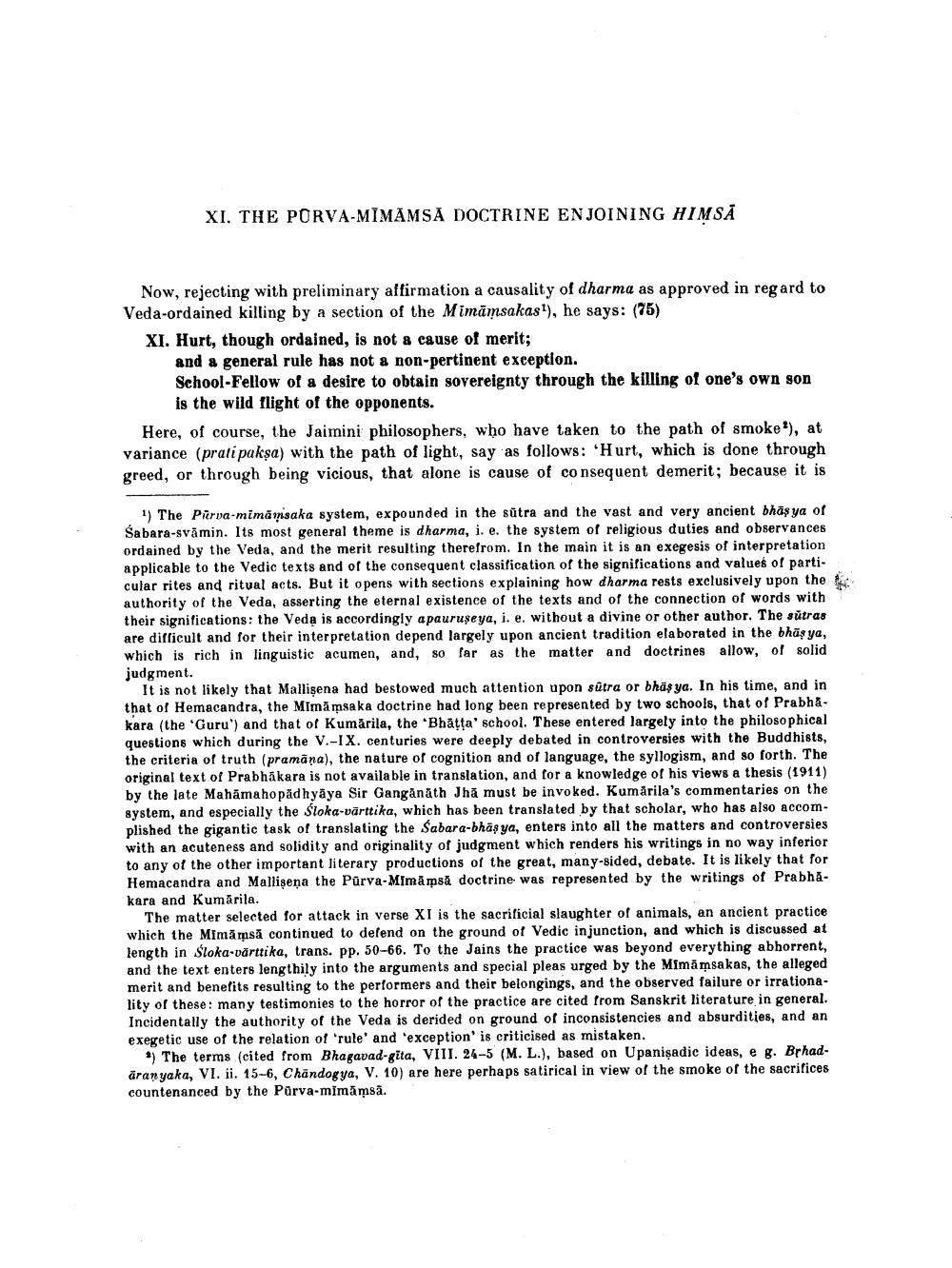________________
XI. THE PURVA-MIMAMSA DOCTRINE ENJOINING HIMSĀ
Now, rejecting with preliminary affirmation a causality of dharma as approved in regard to Veda-ordained killing by a section of the Mimamsakas1), he says: (75)
XI. Hurt, though ordained, is not a cause of merit;
and a general rule has not a non-pertinent exception.
School-Fellow of a desire to obtain sovereignty through the killing of one's own son is the wild flight of the opponents.
Here, of course, the Jaimini philosophers, who have taken to the path of smoke"), at variance (prati paksa) with the path of light, say as follows: 'Hurt, which is done through greed, or through being vicious, that alone is cause of consequent demerit; because it is
1) The Pirva-mimamsaka system, expounded in the sutra and the vast and very ancient bhasya of Sabara-svamin. Its most general theme is dharma, i. e. the system of religious duties and observances ordained by the Veda, and the merit resulting therefrom. In the main it is an exegesis of interpretation applicable to the Vedic texts and of the consequent classification of the significations and values of particular rites and ritual acts. But it opens with sections explaining how dharma rests exclusively upon the authority of the Veda, asserting the eternal existence of the texts and of the connection of words with their significations: the Veda is accordingly apauruşeya, i. e. without a divine or other author. The sutras are difficult and for their interpretation depend largely upon ancient tradition elaborated in the bhas ya, which is rich in linguistic acumen, and, so far as the matter and doctrines allow, of solid judgment.
It is not likely that Mallisena had bestowed much attention upon sutra or bhas ya. In his time, and in that of Hemacandra, the Mimämsaka doctrine had long been represented by two schools, that of Prabhakara (the 'Guru') and that of Kumarila, the 'Bhatta' school. These entered largely into the philosophical questions which during the V.-IX. centuries were deeply debated in controversies with the Buddhists, the criteria of truth (pramana), the nature of cognition and of language, the syllogism, and so forth. The original text of Prabhakara is not available in translation, and for a knowledge of his views a thesis (1911) by the late Mahamahopadhyaya Sir Ganganath Jha must be invoked. Kumärila's commentaries on the system, and especially the Śloka-värttika, which has been translated by that scholar, who has also accomplished the gigantic task of translating the Sabara-bhas ya, enters into all the matters and controversies with an acuteness and solidity and originality of judgment which renders his writings in no way inferior to any of the other important literary productions of the great, many-sided, debate. It is likely that for Hemacandra and Mallisena the Pürva-Mimämsă doctrine was represented by the writings of Prabhăkara and Kumārila.
The matter selected for attack in verse XI is the sacrificial slaughter of animals, an ancient practice which the Mimamsă continued to defend on the ground of Vedic injunction, and which is discussed at length in Sloka-värttika, trans. pp. 50-66. To the Jains the practice was beyond everything abhorrent, and the text enters lengthily into the arguments and special pleas urged by the Mimamsakas, the alleged merit and benefits resulting to the performers and their belongings, and the observed failure or irrationality of these: many testimonies to the horror of the practice are cited from Sanskrit literature in general. Incidentally the authority of the Veda is derided on ground of inconsistencies and absurdities, and an exegetic use of the relation of 'rule' and 'exception' is criticised as mistaken.
*) The terms (cited from Bhagavad-gita, VIII. 24-5 (M. L.), based on Upanisadic ideas, e g. Brhadaranyaka, VI. ii. 15-6, Chandogya, V. 10) are here perhaps satirical in view of the smoke of the sacrifices countenanced by the Purva-mimāmsā.




